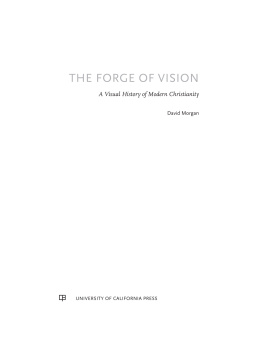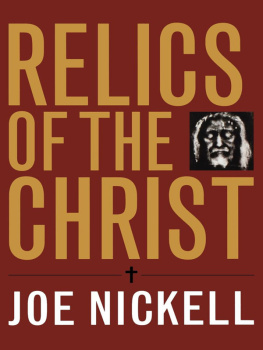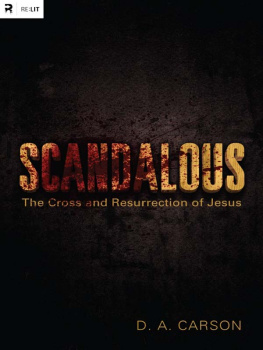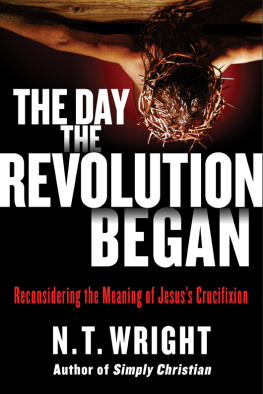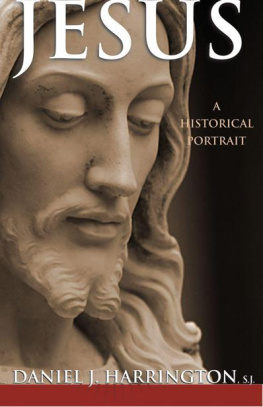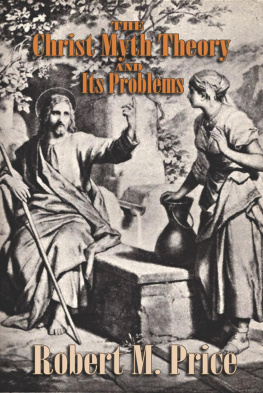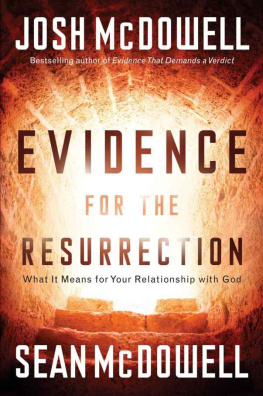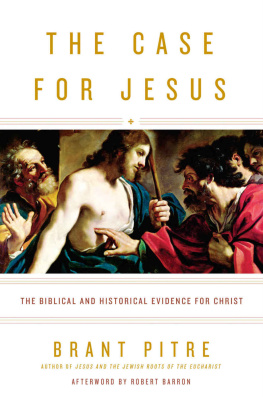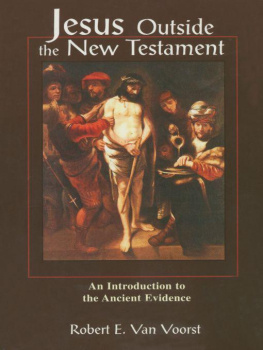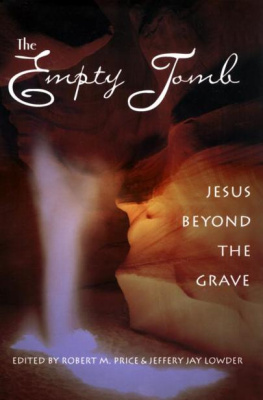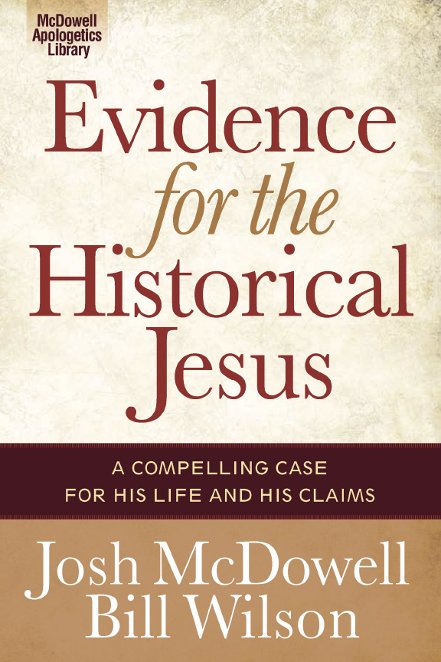
Evidence
for the
Historical
Jesus
Evidence
for the
Historical
Jesus
Josh McDowell
Bill Wilson

HARVEST HOUSE PUBLISHERS
EUGENE, OREGON
Unless otherwise indicated, all Scripture quotations are taken from the New American Standard Bible, 1960, 1962, 1963, 1968, 1971, 1972, 1973, 1975, 1977 by The Lockman Foundation. Used by permission. (www.Lockman.org)
Scripture quotations marked NIV are taken from the Holy Bible, New International Version, NIV. Copyright 1973, 1978, 1984 by Biblica, Inc. Used by permission of Zondervan. All rights reserved worldwide.
Verses marked RSV are taken from the Revised Standard Version of the Bible, copyright 1946, 1952, 1971 by the Division of Christian Education of the National Council of the Churches of Christ in the U.S.A. Used by permission. All rights reserved.
Cover by Koechel Peterson & Associates, Inc., Minneapolis, Minnesota
EVIDENCE FOR THE HISTORICAL JESUS
Copyright 1988, 1993 by Josh McDowell Ministry and Bill Wilson
Published by Harvest House Publishers
Eugene, Oregon 97402
www.harvesthousepublishers.com
Library of Congress Cataloging-in-Publication Data
McDowell, Josh.
[He walked among us]
Evidence for the historical Jesus / Josh McDowell and Bill Wilson.
p. cm.
Originally published: He walked among us. San Bernardino, CA : Heres Life Publishers, 1988.
ISBN 978-0-7369-2871-7 (pbk.)
1. Jesus ChristHistoricity. I. Wilson, Bill, 1948- II. Title.
BT303.2.M42 2011
232.908dc22
2010021676
All rights reserved. No part of this publication may be reproduced, stored in a retrieval system, or transmitted in any form or by any meanselectronic, mechanical, digital, photocopy, recording, or any otherexcept for brief quotations in printed reviews, without the prior permission of the publisher.
Printed in the United States of America
11 12 13 14 15 16 17 18 19 / LB-SK / 10 9 8 7 6 5 4 3 2 1
CONTENTS
Special thanks
to Jo Bristow for typing all 719 pages of the first draft of the manuscript;
to Jean Bryant for her diligent and perceptive work in editing and formatting the book;
to Steve Gillespie, Marcus Maranto, Jim Pourchot and Leroy Tennison for carrying the load of research in other areas while we focused the needed amount of attention on this subject;
to Steve Dunn for his insights and input on specialized areas of the project;
and especially to our wives, Dottie McDowell and Sharon Wilson, for their commitment, diligence and help in passing on to our children what we have received, the good news about Jesus.
A fter many of the quotes in this book you will see a reference code in small type, such as (GreM.MA 23-24) . The first capital and lower case letters are taken from the authors last name (Gre = Green), and the next letter or letters (before the period) are from the authors first name (M = Michael).
The letters after the period refer to the title (MA = Man Alive!), and the numbers (23-24) refer to pages of the particular work quoted. Thus, the above example would direct you to pages 23 and 24 of Man Alive! written by Michael Green.
Some references are followed by [AS], [RS] or [R]. These abbreviations denote the section of the bibliography where the work is found: AS = Ancient Sources; RS = Rabbinic Sources; R = Reference Works.
A complete list of the codes and the sources to which they refer will be found in the bibliography.
H ow many times have you asked yourself these questions: Who was Jesus, anyway? What was he really like? Or, as British New Testament scholar R. T. France questions:
How much of our traditional understanding of Jesus is the product not so much of the historical records as of pious imagination and sentimentality? How much of it has the effect of turning Jesus into a man of our own culture, or, still worse, of no culture at all, thus effectively cutting him off from real life?Are we not still slightly shocked at the thought that Jesus could have had a real sense of humour, or held political views? (FrR.E 158)
Doesnt it ever bother you, the critics will ask, that there seem to be relatively few references to Jesus outside of Christian writings? The fact that almost all we know about him comes from Christian documents has led some scholars to deny that he ever existed at all. Bruno Bauer, Paul Louis Couchoud, G. Gurev, Rudolf Augstein, and most recently, G. A. Wells have argued against the existence of Jesus. Others, as Dr. James H. Charlesworth of Princeton Theological Seminary puts it, will assuredly wish to ask the following question: Is it not obvious that one conclusion of New Testament research is that nothing can be known assuredly about the Jesus of History? (ChJ.R 9)
Did Jesus ever live? Most scholars will admit that a man known as Jesus of Nazareth did live in the first century and that his life was the source of various reports which circulated about him. Only a few insist that Jesus never lived at all.
The question that is hotly debated today, however, is: Did Jesus of Nazareth actually live the kind of life the gospel accounts say he lived? Was he actually the kind of person the Bible portrays him to be? A stream of new books continues to present Jesus as anything but the figure described in the gospel accounts. He is portrayed as a magician, a zealot, an Essene, a guru and world traveler, as one who used hypnosis, and as the husband of Mary Magdalene with whom he procreated into existence a secret lineage and society to rule the world. He is presented as a gnostic, an astronaut from outer space, a deceiver who plotted his own resurrection and as nothing more than a code name for a sacred hallucinogenic mushroom allegedly used by the first Christians.
We desire, on the other hand, to present reliable evidence to portray as accurately as possible what the historical Jesus actually was like.
Consider a statement by John Gribbin in his popular book, In Search of the Double Helix: Quantum Physics and Life:
Ask devout Christians whether they believe that Christ died and rose again, and they will say that of course they do. Ask them for evidence, and they will be baffled by the question. It is not a matter of evidence, but of belief; asking for evidence indicates doubt, and with doubt there is no faith. (GriJ.IS 21-23)
Gribbin obviously misunderstands faith and the nature of evidence. Faith is not simply believing something in the absence of evidenceone aspect of biblical faith is believing what the Bible says based on the evidence available to us. This is why religion and philosophy professor Charles Anderson is correct in declaring:
It cannot be stated too strongly that Christianity is an historical religion, and that it is so intimately tied to history that if the historical credibility of its sources were to be proven false, it would at once collapse as a possible claimant for our loyalty. (AnC.CQ 55)
E. M. Blaiklock, former Professor of Classics at University College, Auckland, New Zealand, adds, Since the Christian faith is rooted in history, to disturb the history is inevitably to disturb the faith. (BlE.MM 48)
The evidence presented in this book should help answer the questions you may have about the life Jesus lived as he walked among the people of the first century.
Next page

